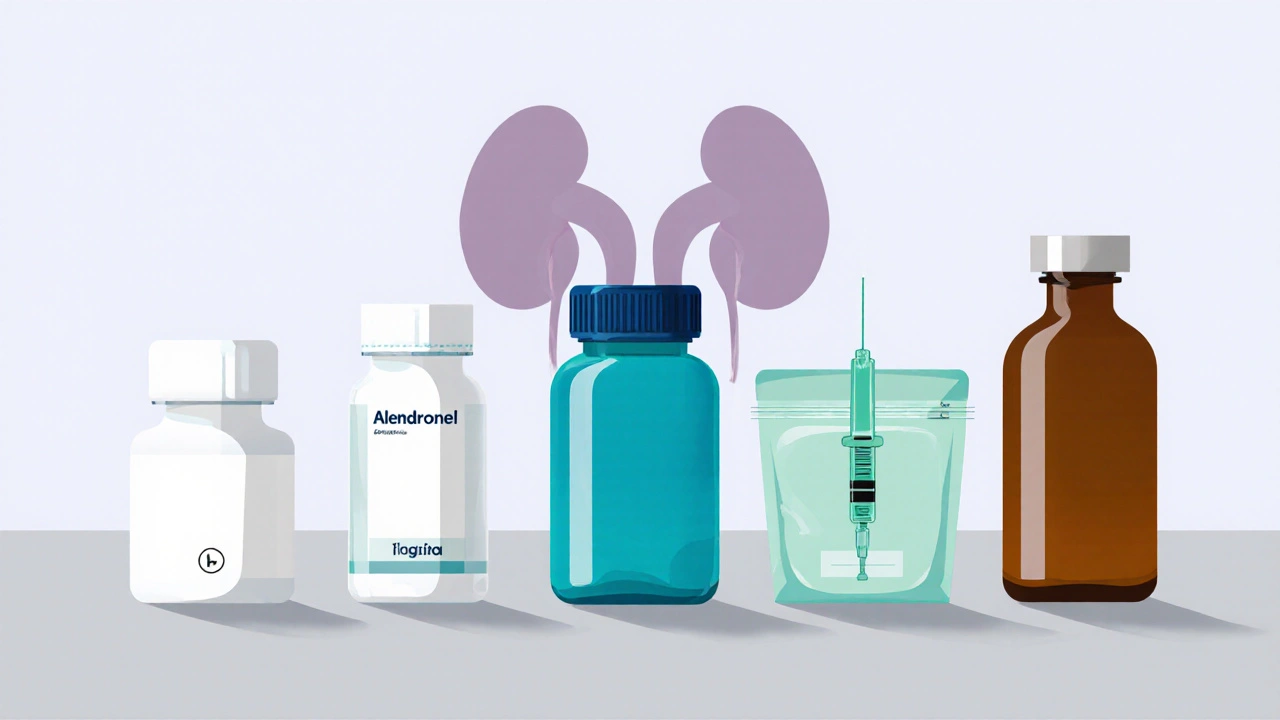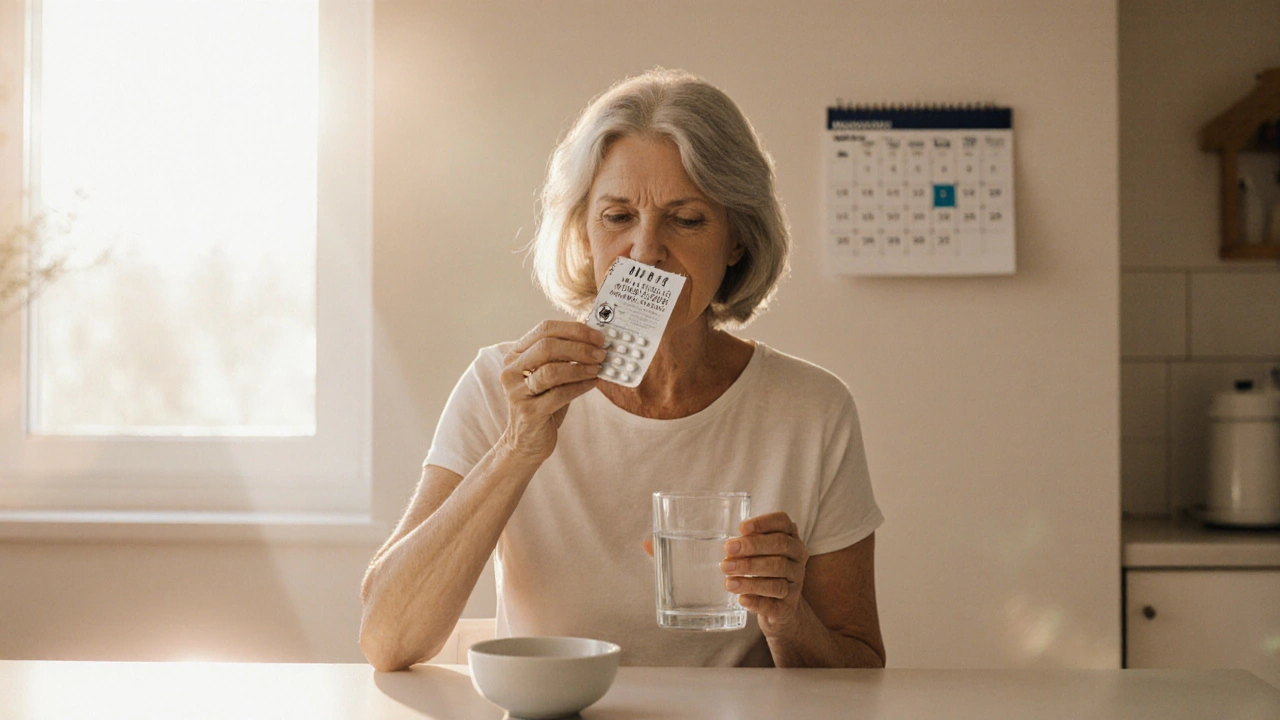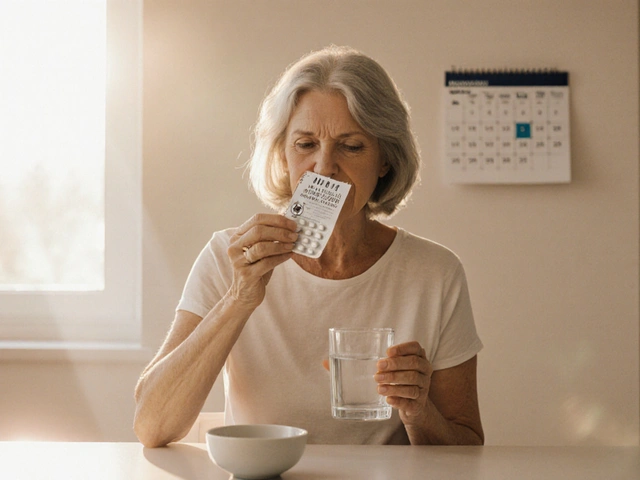Osteoporosis Medicine Comparison Tool
Medication Details
Key Considerations
Side Effects
Actonel is often the first drug doctors prescribe for post‑menopausal osteoporosis, but it isn’t the only game‑changer on the market. If you’re weighing Actonel against other options, you’ll want to know how they differ in dosing, side‑effects, kidney safety, and price. Below is a straight‑to‑the‑point guide that lets you compare the most common alternatives and decide which fits your lifestyle and health profile.
Quick Take
- Actonel (risedronate) is a weekly oral bisphosphonate taken on an empty stomach.
- Alendronate (Fosamax) is similar but requires daily or weekly dosing and has a slightly higher gastrointestinal‑irritation rate.
- Ibandronate (Boniva) can be taken monthly, which many find easier to remember.
- Zoledronic acid (Reclast) is a once‑yearly IV infusion-great for those who forget pills.
- Denosumab (Prolia) works via a different pathway, is given subcutaneously every six months, and is kidney‑friendly.
How Actonel Works
When you first see Actonel a weekly oral bisphosphonate that inhibits bone‑resorbing osteoclasts, the key point is its ability to keep the bone‑remodeling balance tipped toward formation. By binding to hydroxyapatite crystals in bone, it makes it harder for osteoclasts to attach and break down bone tissue. The result: higher bone mineral density (BMD) and fewer vertebral fractures over three to five years.
Alternative Osteoporosis Medicines
Below are the most frequently prescribed alternatives, each with its own mechanism and dosing rhythm.
Alendronate another oral bisphosphonate, usually taken daily or weekly works the same way as Actonel but has a slightly longer half‑life, which may translate to modestly greater BMD gains in some studies.
Ibandronate a monthly oral bisphosphonate that can also be given as a quarterly IV injection offers a convenient dosing schedule, though its fracture‑prevention data are strongest for vertebral fractures only.
Zoledronic acid a powerful IV bisphosphonate administered once a year is ideal for patients who struggle with oral adherence but requires a hospital visit and careful kidney monitoring.
Denosumab a monoclonal antibody that blocks RANKL, reducing osteoclast formation is given as a subcutaneous injection every six months. It works for people with severe kidney disease where bisphosphonates are risky.
Romosozumab an anti‑sclerostin antibody that both builds bone and slows resorption is a monthly injection approved for very high‑risk patients; cost is a major consideration.
Adjuncts such as calcium supplements elemental calcium sources like calcium carbonate or citrate and vitamin D vitamin D3 (cholecalciferol) to improve calcium absorption are recommended alongside any prescription medication to maximize BMD gains.

Side‑Effect Profile at a Glance
All bisphosphonates share a few common issues: stomach upset, esophageal irritation, and rare atypical femur fractures after years of use. The table below highlights the most frequent side effects for each drug class.
| Medicine | Mechanism | Dosing Frequency | Route | Common Side Effects | Renal Considerations | Approx. Annual Cost (USD) |
|---|---|---|---|---|---|---|
| Actonel (Risedronate) | Bisphosphonate - inhibits osteoclasts | Weekly | Oral | Upper GI irritation, rare jaw osteonecrosis | Contraindicated if CrCl < 30mL/min | $150‑$200 |
| Alendronate (Fosamax) | Bisphosphonate - inhibits osteoclasts | Weekly or daily | Oral | Esophagitis, muscle pain | Same as Actonel | $120‑$180 |
| Ibandronate (Boniva) | Bisphosphonate - inhibits osteoclasts | Monthly (oral) / Quarterly (IV) | Oral or IV | Stomach upset, flu‑like symptoms (IV) | Moderate; monitor if CrCl 30‑60mL/min | $200‑$260 |
| Zoledronic acid (Reclast) | Bisphosphonate - potent osteoclast inhibitor | Once‑yearly | IV infusion | Acute phase flu‑like reaction, renal toxicity | Requires CrCl > 35mL/min | $400‑$500 |
| Denosumab (Prolia) | Monoclonal antibody - blocks RANKL | Every 6months | Subcutaneous injection | Skin rash, hypocalcemia, rare infection | Kidney‑friendly; adjust calcium/VitD | $1,200‑$1,500 |
| Romosozumab (Evenity) | Anti‑sclerostin - builds bone & slows resorption | Monthly | Subcutaneous injection | Injection site reaction, cardiovascular alerts | Safe for most renal levels | $3,500‑$4,000 |
Choosing the Right Option for You
Every patient’s situation is a mix of age, kidney function, fracture risk, and lifestyle preferences. Here’s a quick decision tree:
- Do you have normal kidney function (eGFR > 60mL/min)? If yes, any oral bisphosphonate (Actonel, Alendronate, Ibandronate) is on the table.
- Do you struggle with daily pill routines? Weekly or monthly oral dosing (Actonel, Ibandronate) cuts down on forgetfulness.
- Are you on a medication that interferes with oral absorption (e.g., NSAIDs, steroids)? An IV option (Zoledronic acid) avoids GI irritation.
- Do you have chronic kidney disease (eGFR < 30mL/min)? Switch to Denosumab, which bypasses the kidneys.
- Is your fracture risk very high (multiple vertebral fractures, very low BMD T‑score < -3.0)? Consider Romosozumab or combination therapy (bisphosphonate followed by Denosumab).
Never start a new drug without a bone‑density test (DXA) and a discussion with your endocrinologist or primary‑care physician. They’ll factor in your calcium‑vitaminD status, other meds, and personal preferences.
Practical Tips & Common Pitfalls
- Take oral bisphosphonates with plain water only. No coffee, juice, or mineral water for 30minutes.
- Stay upright for at least 30minutes after swallowing; sitting or lying down can cause esophageal irritation.
- Check calcium and vitaminD levels every 6‑12months; low levels blunt the drug’s effect.
- If you miss a weekly dose, skip it and resume the next scheduled day-don’t double up.
- Watch for “atypical femur fracture” symptoms (new thigh or groin pain) after 3+ years of bisphosphonate use; discuss a drug holiday with your doctor.
Frequently Asked Questions
Can I switch from Actonel to another bisphosphonate?
Yes. Most clinicians prefer a short drug‑free interval (usually 1‑2 weeks) before starting the new bisphosphonate to reduce GI overlap. A bone‑density scan after the switch helps track effectiveness.
Is Denosumab safer for people on blood thinners?
Denosumab itself doesn’t increase bleeding risk, but the required calcium and vitaminD supplements can interact with certain anticoagulants. Always review with your pharmacist.
How long can I stay on Actonel?
Typical treatment spans 3‑5years. After that, doctors often suggest a “drug holiday” if BMD has improved, followed by reassessment.
What if I have gastro‑esophageal reflux disease (GERD)?
Consider a monthly oral bisphosphonate (Ibandronate) or an IV option (Zoledronic acid) that bypasses the esophagus entirely.
Are there any diet changes that boost Actonel’s effect?
Aim for 1,000‑1,200mg of calcium and 800‑1,000IU of vitaminD daily. Dairy, fortified plant milks, leafy greens, and safe sun exposure help meet these targets.







David Ross October 1, 2025
Wow, this comparison chart is super helpful, and I love how clearly each medication’s pros and cons are laid out, especially the kidney‑safety notes! It’s great to see practical tips like “stay upright for 30 minutes” right alongside the dosing schedules, and that will definitely help many of us avoid nasty esophageal irritation, haha! Keep the friendly tone coming, and thank you for making such a complex topic feel approachable!
Henry Seaton October 2, 2025
We have to look out for our own health first. This guide is okay but it forgets that American doctors know best. People should just stick with the meds made in the US.
Baby Thingie October 3, 2025
The article presents the data accurately and concisely. It references dosing intervals and renal considerations without superfluous detail. :)
Abby Elizabeth October 4, 2025
Ugh, this write‑up is sooo boring, like seriously, who has time to read all that table junk? i cant even focus on the cost numbers – they’re just a nightmare, omg! Also, the tone is so dry it makes me want to scream!!! i wish they would add some sparkle, maybe a meme?
Mark Haycox October 6, 2025
Look, the US med industry is top notch and any foreign drug is just a gimmick, no need to waste time on denosumab when risedronate works fine. The data is all over the place, but i think the author missed the point that cheap bisphosponates are better. Also the wording is full of errors, definatly not professional.
Michael Taylor October 7, 2025
I really appreciate the thoroughness of this comparison, because navigating osteoporosis treatments can feel like wandering through a maze of medical jargon. The weekly schedule of Actonel, for example, fits nicely into many people's routines, especially those who struggle with daily pill fatigue. At the same time, the monthly option of Ibandronate offers a nice middle ground, reducing the chance of missed doses while still avoiding the inconvenience of an annual infusion. And let’s not forget that Zoledronic acid, administered just once a year, can be a lifesaver for patients who simply cannot remember to take oral meds, provided they have adequate kidney function. Speaking of kidneys, the table does a solid job highlighting renal thresholds, which is critical because many bisphosphonates can be nephrotoxic if not used carefully. Denosumab shines in this respect, as it bypasses the kidneys entirely, making it a go‑to choice for those with chronic kidney disease. However, the cost of Denosumab is markedly higher, and that financial burden can be a real barrier for many patients, despite its clinical benefits. Romosozumab, while offering both bone‑building and anti‑resorptive effects, carries a steep price tag and a warning label about cardiovascular risk, so it’s reserved for the highest‑risk individuals. The side‑effect profiles are also well‑summarized; gastrointestinal irritation remains the most common complaint with oral bisphosphonates, and patients should always take the pills with plain water and stay upright. In addition, the rare but serious concern of osteonecrosis of the jaw should prompt clinicians to ensure proper dental exams before initiating therapy. Calcium and vitamin D supplementation, mentioned toward the end, cannot be overstated-they are the foundation upon which these drugs build stronger bones. I also love the practical tip about missing a weekly dose; skipping rather than doubling up prevents unnecessary side effects and maintains efficacy. Overall, the decision tree is a handy visual aid, guiding patients through considerations like kidney function, fracture risk, and personal preference with clarity. It encourages shared decision‑making between the patient and the healthcare provider, which is exactly how we should approach chronic disease management. If you’re still unsure, a bone‑density scan (DXA) can provide the objective data needed to tailor therapy further. Bottom line: there’s no one‑size‑fits‑all answer, but this guide equips you with the knowledge to make an informed, personalized choice.
Troy Brandt October 8, 2025
You've nailed the key points about dosing flexibility, and I want to add that staying consistent with supplementation can really boost the effectiveness of any of these therapies; consider checking vitamin D levels every few months, and don't hesitate to discuss potential drug holidays with your doctor if you've been on a bisphosphonate for several years. Moreover, patient education on proper pill administration-plain water, upright posture-can dramatically reduce gastrointestinal side effects. If a patient experiences persistent throat irritation, switching to a monthly formulation like Ibandronate or an IV option may be wise. Also, remember that adherence tends to improve when the regimen aligns with the individual's lifestyle, so tailor the schedule accordingly. Finally, keep an eye on bone turnover markers if your endocrinologist orders them; they can give early insight into treatment response.
Barbra Wittman October 9, 2025
Oh, brilliant, another exhaustive table that makes me feel like I'm back in med school-just what I needed on a lazy Sunday. The color‑coded side‑effect badges are practically screaming for attention, because who doesn't love a little visual drama with their pharmacology? It's comforting to know that zoledronic acid's "once‑yearly infusion" is there, just in case you enjoy scheduling hospital visits like holiday parties. And the cost column? Nothing says "patient‑friendly" like a five‑digit number; I guess bone health is a premium hobby now. Thanks for the thrill ride through spreadsheets, it really brightened my day.
Gena Thornton October 10, 2025
The cost figures are indeed steep, but many insurance plans cover a significant portion of Denosumab and Romosozumab, especially for high‑risk patients; checking prior authorization requirements can often reduce out‑of‑pocket expenses. Additionally, some pharmaceutical assistance programs offer coupons or free‑drug programs for eligible individuals, which can make these high‑priced therapies more accessible.
Lynnett Winget October 11, 2025
Hey there, bone‑builder! 🌈 This guide is like a vibrant rainbow of options-each pill, injection, or drip adding its own splash of color to the canvas of your skeletal health. Whether you groove to a weekly rhythm like Actonel or dance to a yearly infusion, there’s a hue that fits your style.
Amy Hamilton October 12, 2025
Indeed, the spectrum of treatments mirrors life's own palette; we must choose wisely, balancing efficacy, safety, and personal values, for the strongest foundation is built not just with medicine but with thoughtful intention.
Lewis Lambert October 13, 2025
When faced with the daunting prospect of osteoporosis, it's natural to feel like you're standing on shaky ground-yet knowledge, like a lighthouse, can guide you toward steadier shores. This comparison equips you with the essential facts to weigh convenience against safety, cost against benefit. Remember, the best choice aligns with both your medical profile and your daily rhythm, turning fear into empowerment.
Tamara de Vries October 14, 2025
yeah totally, i guess the key is just finding what fits ur schedule and health status, no need to overthink it, just talk to ur doc and go with what feels right.
Jordan Schwartz October 15, 2025
Thanks for the comprehensive breakdown!